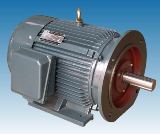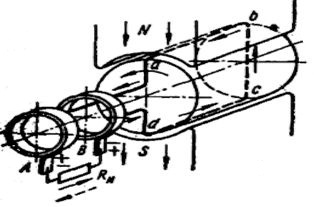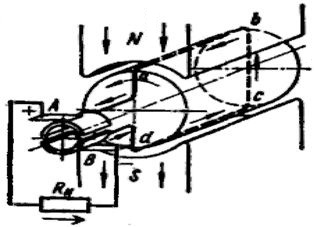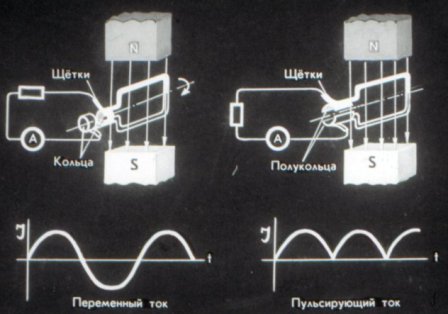Reversibility of electrical machines
Basic provisions of the principle of reversibility of electrical machines
 According to Bio-Savard's law, the force F = Bli, (VA) acts on a conductor moving in a magnetic field with a current I, which direction is determined by the left-hand rule. Therefore, if you bring the brushes to an AC machine alternating current, then a force will arise that will cause the wires ab and cd to move in a magnetic field, and the coil ab° Сd will begin to rotate (Fig. 1).
According to Bio-Savard's law, the force F = Bli, (VA) acts on a conductor moving in a magnetic field with a current I, which direction is determined by the left-hand rule. Therefore, if you bring the brushes to an AC machine alternating current, then a force will arise that will cause the wires ab and cd to move in a magnetic field, and the coil ab° Сd will begin to rotate (Fig. 1).
It is only necessary that the frequency is the current corresponds to the rotation frequency during the start-up period note f = pn... A similar phenomenon will occur if a direct current is applied to the brushes of a DC machine. Collector in this case it will play the role of an inverter, converting the supplied direct current into alternating current inside the armature (see Fig. 2).
This is how we get an electric motor, which, unlike a generator, converts electrical energy into mechanical energy.
According to Lenz's law, the induced current always has a direction in which the emerging electromagnetic force tends to impede the change (motion) due to which the current is induced.

Rice. 1.The simplest alternator

Rice. 2. The simplest DC generator

Rice. 3. The generator gives an alternating emf if the ends of the frame are connected to the rings. If they are connected to half rings (collector plates), the current in the circuit will be pulsating.
Based on the laws mentioned above and the principle of operation of the simplest electrical machines, we can formulate the following basic provisions for energy conversion:
1) direct reciprocal transformation of mechanical and electrical energy in inductive electrical machines is possible only when the latter is alternating current energy,
2) such energy conversion requires an electric circuit with a changing inductance (in our case, it is a loop rotating in a magnetic field),
3) to convert alternating current into direct current, there must be a changing electrical resistance in the electrical circuit (its role in electrical machines is played by the brush-collector contact, the resistance of which changes from infinity when the brush does not touch the collector plate, to certain minimum value when the brush completely overlaps the plate),
4) every electric machine is energetically reversible, that is, in principle, it can work equally both as a generator and as a motor,
5) since for manifestation the law of electromagnetic induction all that is needed is the relative motion of the wire and the magnetic field, then any electrical machine is kinematically reversible, that is, it can turn either an armature or an inductor.
Is it practically possible to use a motor instead of a generator?
According to the law of E. X.Lenz, the induced current in a closed electric circuit always has a direction in which the emerging electromagnetic force tends to prevent that change (motion) due to which the electric current is induced. On this basis, any induction electric machine is "energy reversible", that is, in principle, it can work both as a generator and as a motor.
However, if you need to know for which mode of operation the electric machine is intended - for a generator or an engine. This is due to the fact that in practice certain requirements are imposed on the generator and the engine, which are not always compatible, and therefore it may turn out, that an electrical machine designed as a generator will not be able to operate satisfactorily as a motor and vice versa.
Therefore, each machine must have an indication on the "plate" for which mode of operation it is intended by the factory that produced it. It should also be noted that a number of types of electrical machines have arisen and are used only as a generator or only as a motor.
Kinematic reversibility of an electric machine
From the point of view of the implementation of energy conversion in an electric machine, only the relative movement of its two main organs is important, followed by the kinematic reversibility of the electric machine.
This means that if the rotor of an electric machine is locked and the stator is allowed to turn, it will begin to turn, while it will turn, with electrical connections unchanged, in the direction opposite to that in which the rotor has turned in the stator rotates (this follows from the laws of mechanics).
Obviously, in order for the stator to rotate, it will need to be fitted with suitable bearings and in addition electrical sliding contacts to maintain the supply of electrical energy to the stator, if any, prior to the conversion. Obviously, with the kinematic circulation of the inner-rotor electric machine, we get an outer-rotor electric machine and vice versa.
